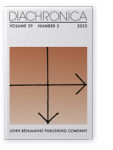Vol. 39:5 (2022) ► pp.616–657
Continuity and change in the evolution of French yes-no questions
A cross-variety perspective
This present study contributes to research on the structure of yes-no questions in French. Informed by previous historical linguistic research tracing developments from the Old French period onwards, we focus on qualitative analysis of grammatical commentary and variationist analysis of Acadian French spoken-language data. We compare the evolution of yes-no questions in Acadian, Metropolitan, and Quebec French, reconstructing the history of variants up to the present. While in most cases we encounter slow-moving change, we do find inter-varietal differences in degree of retention of individual variants, including outright loss; in development of stylistic differentiation; and in analogically based innovation. We also find inter-varietal differences in grammatical constraints governing usage and in the fine detail regarding sentential polarity, illuminated in terms of the semantico-pragmatic functions of negative yes-no questions. The overall results underline the importance of considering sociolinguistic histories, including histories of dialect contact, along with local linguistic markets.
Article outline
- 1.Introduction
- 2.The speech communities
- 2.1Acadian French
- 2.2The communities
- 2.3The corpora
- 3.Yes-no questions in French
- 4.History of the variants
- 4.1The “inversion” variants
- 4.2 Est-ce-que… and the TI particle
- 4.3Rising intonation
- 4.4The TU particle
- 4.5Summary
- 5.Contemporary research
- 5.1Metropolitan French and other Gallo-Romance varieties
- 5.2Quebec French
- 5.3Acadian French
- 6.The variable context
- 6.1Inclusions
- 6.2Exclusions
- 7.Potential conditioning factors
- 7.1Grammatical subject
- 7.2Form of third person subjects
- 7.3Number of syllables in the finite verb
- 7.4Sentential polarity
- 7.5Form of the verb (simple or compound)
- 7.6Finite and lexical verb form
- 7.7Sociodemographic variables
- 8.Results
- 8.1Overall rates of the variants per community
- 8.2Analysis of factors per community
- 8.3The case of negation
- 9.Discussion and conclusions
- Acknowledgements
- Notes
- Abbreviations
-
References
